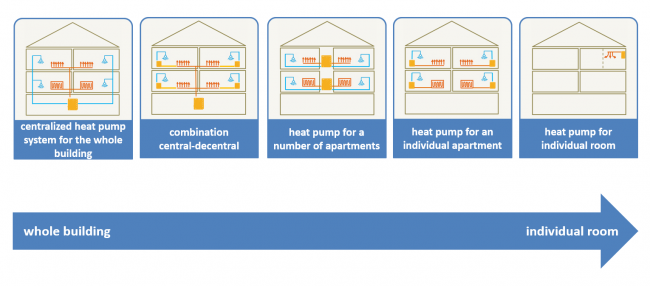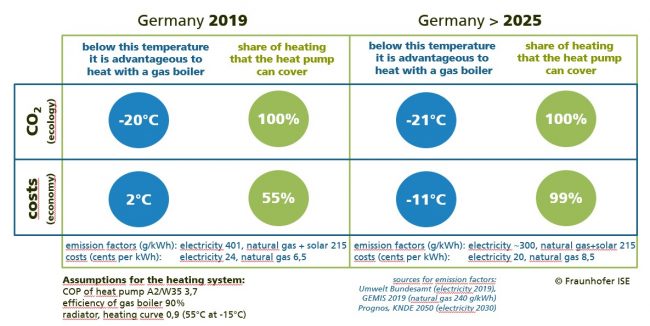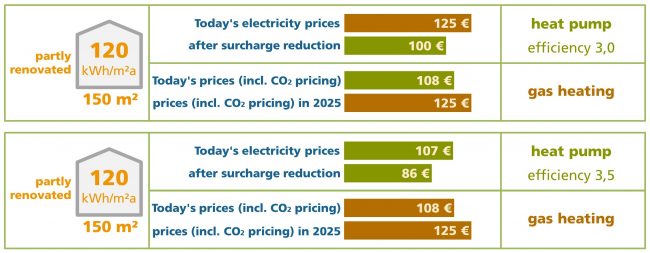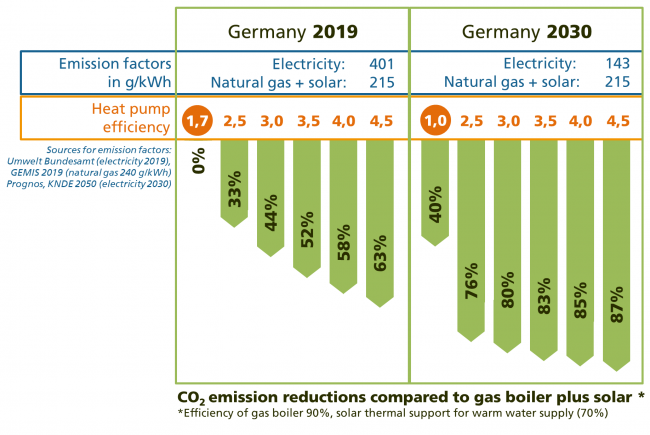Series “Heat Pumps in Existing Buildings”
BLOG POST SERIES | 10 Feb. 2021
How can heat pumps be used in existing buildings? Do all existing buildings have to be extensively retrofitted first?
Are heat pumps able to guarantee sufficiently high flow temperatures required? Can they achieve sensible efficiency values in existing buildings? And is this operation actually ecological?
In order to provide well-founded answers to these and other questions and to create a good basis for future decision-making, we have commissioned the Fraunhofer Institute for Solar Energy Systems with a blog post series on “Heat Pumps in Existing Buildings”.
The twelve blog posts will be published weekly on the Fraunhofer ISE science blog. They are based on the knowledge and experience gained from almost twenty years of heat pump research at Fraunhofer ISE. In the blog posts, the various arguments against heat pumps in existing buildings will be analyzed and contrasted with various research results.
EPISODE 12 | 20 May 2021
Final episode of a series on heat pumps in existing buildings:
We should have courage to bet on the right technology
75% of residential buildings in Germany are older than 40 years. The figure illustrates how important it is to pursue the right energy strategy for existing buildings. Wherever possible, heating energy requirements should be reduced first. In the long term, this is will be essential anyway. However, the replacement of the heating device cannot always wait until after the energetical refurbishment of the building. This fact is often used as an argument against heat pumps. In our blog series “Heat Pumps in Existing Buildings”, we provided evidence proving that this assumption is wrong. It is possible (and necessary) to successfully use heat pumps in existing buildings from an ecological and economical point of view.
EPISODE 11 | 07 May 2021
Can heat pumps only be used in one- and two-family houses?
Heat pumps are mostly used for heating in detached and semi-detached houses. However, around 40% of the living space is provided by multi-family houses (MFH). Three-quarters of these are buildings with three to twelve residential units. To meet our climate targets, heat pumps must also be used to a greater extent in multifamily buildings – both in new and existing buildings. This episode describes that heat pump systems can also be used successfully in multifamily buildings. Numerous examples from European and Asian countries in different climate zones and with different urban planning conditions underscore this: https://heatpumpingtechnologies.org/annex50/case-studies/
EPISODE 10 | 29 Apr. 2021
Is it better to combine a heat pump with fossil heating in some cases?
When another heat generator (for example, gas or oil boiler) provides the heating in addition to the heat pump, we talk about “bivalent” or hybrid systems. This blog post describes when hybrid systems are considered – for ecological or cost reasons. The comparisons presented show that hybrid systems already do not make sense for environmental reasons compared to heat pump only operation. The operating cost consideration still shows a certain advantage with the gas boiler at today’s prices, but this will quickly change in favor of a pure heat pump operation.
EPISODE 9 | 23 Apr. 2021
Is it worth waiting for technological developments before switching to a heat pump?
Whether it’s worth waiting any longer to install a heat pump depends on two considerations: Is the technology at today’s level ready for satisfactory use in existing buildings? And: What advantages, if any, can be expected from further technological developments?
In this blog post, we look at the technological developments of recent years and current technological trends. It becomes clear: From the customer’s point of view, there is no reason to wait for further technological developments and not install a heat pump for the time being. There are already many different products on the market today, each of which can meet specific requirements. Future heat pump models will probably be quicker and easier to install, or will even be able to optimize themselves during operation. However, the devices will not be “much better suited” in principle, even for existing buildings.
EPISODE 8 | 14 Apr. 2021
Isn’t heating with heat pumps too expensive?
Heat pumps will only become widely accepted if they pay off for the consumer. This blog post looks at the decisive factor of operating costs. The energy standard of the building, the size of the heated area and the efficiency of the heat pump are central to this. In comparison with other heating systems, the focus is on energy costs. Reducing electricity prices is a key strategy for increasing the attractiveness of heat pumps compared to fossil heating systems.
EPISODE 7 | 24 Mar. 2021
How ecological are heat pumps in existing buildings?
The carbon footprint of the heating technology used is of central importance for decarbonizing the heat supply to buildings. Heat pumps can already replace fossil fuel-based heating systems on a large scale. But how high are the CO2 emission savings from heat pumps compared to gas heating? This blog post outlines which factors are crucial for the CO2 savings of heat pumps. Already today, heat pumps save on average about half of CO2 emissions compared to gas heating. With an increasingly greener electricity mix, these savings will become even greater.
EPISODE 6 | 17 Mar. 2021
How well have heat pumps performed in practice in partially refurbished and unrefurbished buildings?
In its research project “WPsmart im Bestand” (in German) the Fraunhofer ISE has analyzed the efficiency of heat pumps in existing buildings. In this blog post we discuss two examples from this field study: Two buildings constructed in the years 1937 and 1973, respectively, which have not been refurbished, or have been renovated only slightly. In both houses heat pumps heat the rooms and the domestic water. Neither building has underfloor heating. The examples show that heat pumps can achieve good efficiency even in houses that have not been refurbished or have only been partially renovated.
EPISODE 5 | 10 Mar. 2021
How much does the use of back-up heaters reduce the efficiency of heat pumps?
Heating systems with heat pumps are usually equipped with a direct-electric back-up heater, which takes over the heat supply from a defined outdoor temperature (for example, -5°C) – either alone or together with the heat pump. This can limit the required size of outside air heat pumps. In comparison to the heat pump, the efficiency of the back-up heater is much worse. If the back-up heater is used frequently, it is bad for operating costs and for ecology. There is often a prejudice against heat pumps that the back-up heater needs to be used frequently and that heating costs will “explode” as a result. This blog post discusses field study results, which clearly disprove this assumption.
EPISODE 4 | 03 Mar. 2021
How well do heat pumps really work in existing buildings?
The question of how well a heat pump works can be answered in particular by looking at its “operating figure”. This indicator describes what efficiency can be expected at certain outdoor and heating temperatures. Within the last 20 years, Fraunhofer-ISE has monitored about 300 heat pumps in the field and determined the operating figures of these systems. This blog post discusses the results of these field tests, which clearly show that heat pumps function reliably also in existing buildings and are ecologically advantageous.
EPISODE 3 | 24 Feb. 2021
Does a house have to be renovated first in order to install a heat pump?
Clearly, the less energy needed to create a comfortable indoor climate, the better. That’s why renovation measures to reduce heating energy demand always make sense. This applies to all heating systems. Fortunately, houses do not have to be extensively renovated before installing a heat pump. This post explains why, in the vast majority of cases, a good heat pump solution can also be implemented in unrenovated (or slightly refurbished) buildings.
EPISODE 2 | 17 Feb. 2021
Heat pumps in existing buildings: Are heat pumps able to deliver sufficiently high temperatures in the heating circuit?
When discussing the possible use of heat pumps in existing buildings, the main counter-argument is the very high temperature of the heating circuit on which they are based. This episode argues: Why the maximum required temperature is not the decisive factor.




